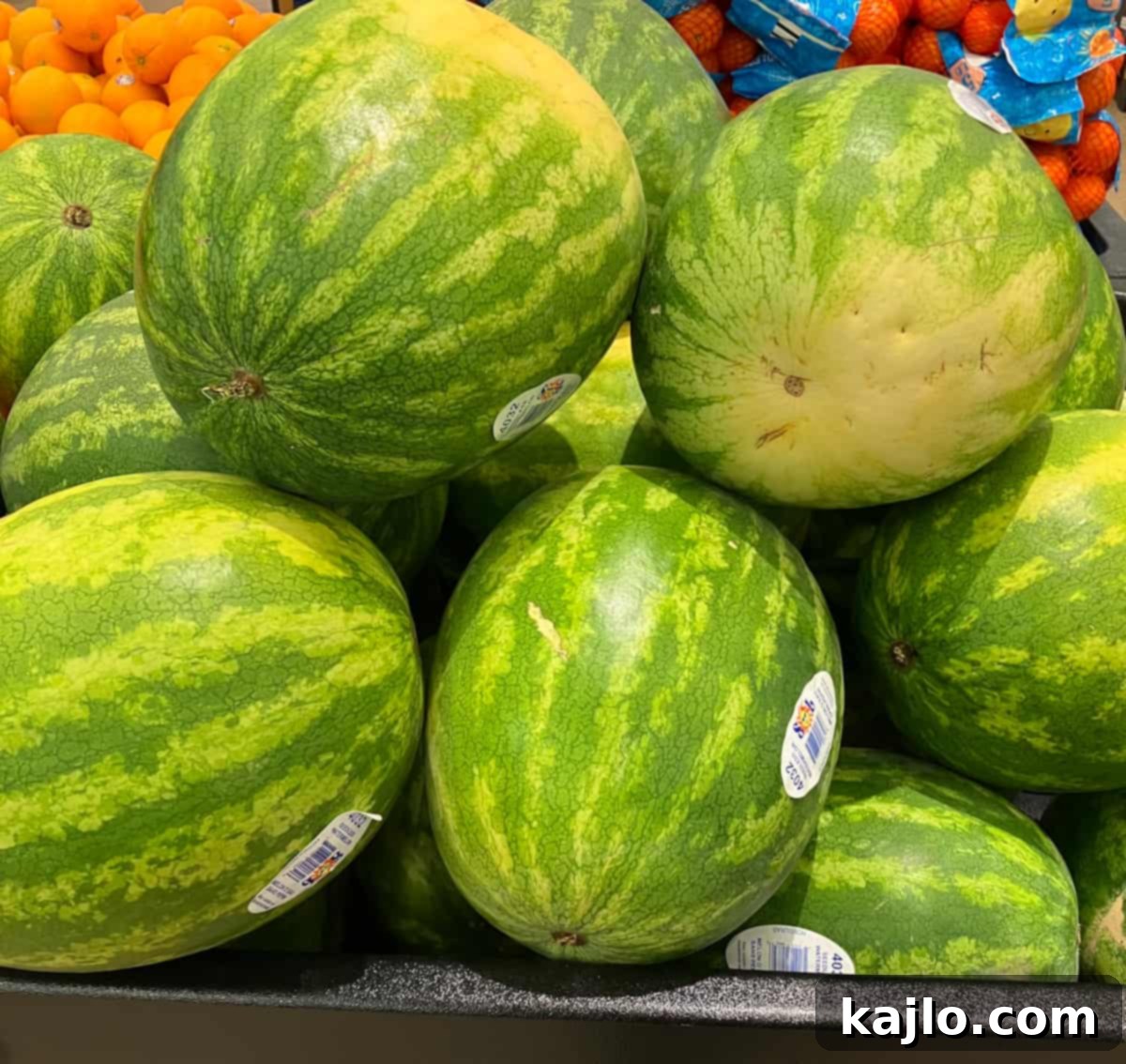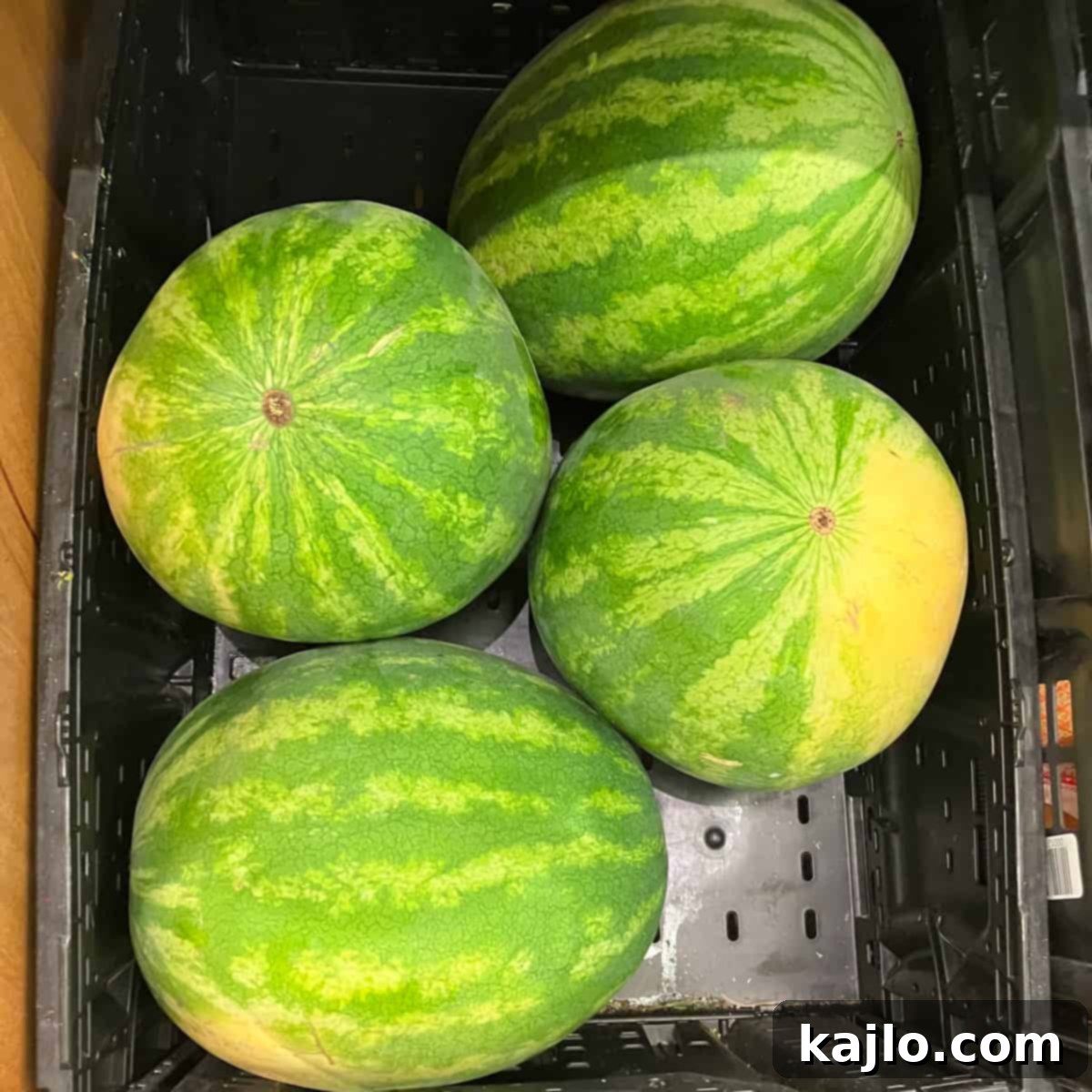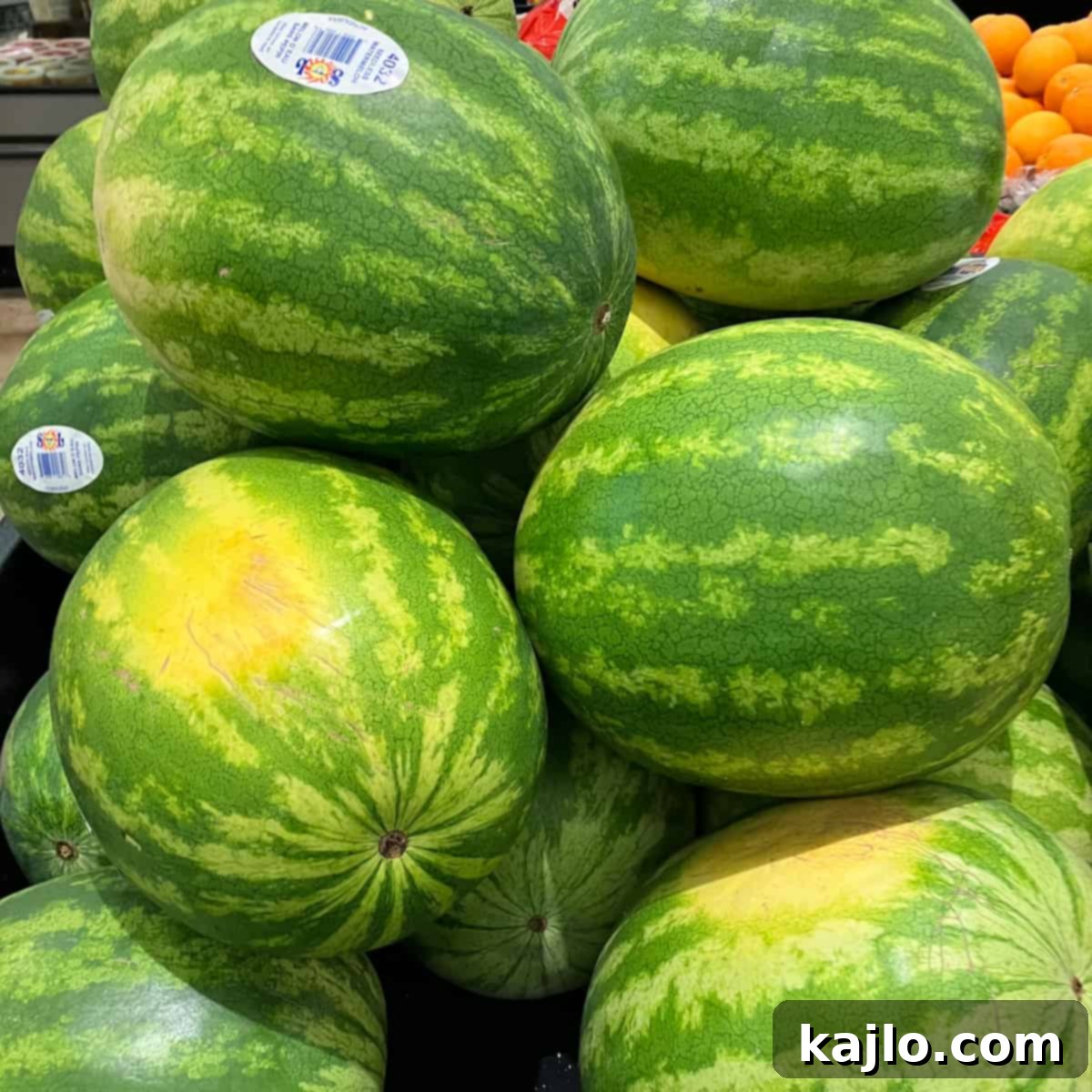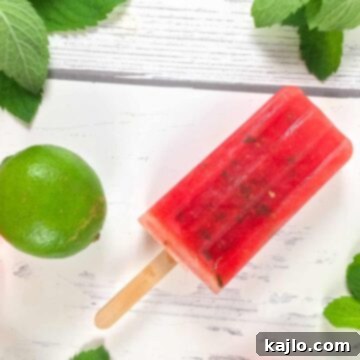Watermelon, a quintessential summer fruit, is celebrated for its refreshing taste and hydrating properties. However, for individuals managing their blood sugar, particularly those with diabetes, questions often arise regarding its sugar content and overall impact on health. This comprehensive guide delves into the nutritional profile of watermelon, exploring its sugar levels, glycemic index, and how it can fit into a balanced diet for diabetics.

🍉 Understanding Watermelon’s Sugar Content
One of the first questions people ask is, “How much sugar is in watermelon?” A standard serving of approximately 1 cup (98 grams) of diced watermelon contains around 6 grams of sugar. It’s crucial to distinguish that all of this sugar is naturally occurring fructose, not added sugar. This natural sweetness is what makes watermelon a delightful treat, yet understanding its quantity is key for dietary planning, especially for those monitoring their carbohydrate intake.
Watermelon is cherished globally for its vibrant color, sweet taste, and remarkably juicy texture. Beyond its appeal, its high water content (over 90%) makes it an excellent choice for hydration, particularly during warmer months. In the following sections, we will thoroughly investigate the sugar levels, scrutinize whether its sugar is beneficial, and provide insights into incorporating this hydrating fruit into various dietary plans.
Are Watermelons High in Sugar? Debunking Common Misconceptions
Many individuals express concern that watermelon might be excessively high in sugar, potentially posing health risks. Surprisingly, when compared to many other fruits, watermelon is not considered a “high sugar” food. To understand this, we refer to definitions provided by health authorities.
According to the FDA’s guidelines, a food is generally classified as “high sugar” if it contains 20% or more of the Daily Value (DV) for sugar. Based on a 2000-calorie diet, the daily value for added sugars is 50 grams. This means a food would need to have 10 grams or more of *added sugar* per serving to be considered high in added sugar. Watermelon, containing only natural sugars, does not fall into this category.
The sugar present in watermelons is primarily fructose, a natural sugar. Natural sugars found in whole foods like fruits, vegetables, and dairy are generally considered safe and healthy when consumed as part of a balanced diet and in moderation. Unlike added sugars, which often come with fewer nutrients and are recommended to be limited in dietary guidelines, the natural sugars in watermelon are packaged with essential vitamins, minerals, and antioxidants, forming a beneficial food matrix.
Delving into the Specifics: Sugar in a Single Cup of Watermelon
As previously mentioned, a single cup of diced watermelon, weighing approximately 98 grams, contains about 6 grams of natural sugar. This relatively low amount typically does not lead to a drastic spike in blood sugar levels, especially when consumed as part of a meal or snack. However, the precise amount of sugar will naturally fluctuate based on the portion size you consume.
For individuals adhering to a carbohydrate-counting diet, such as many diabetics, understanding portion control is paramount. One carbohydrate exchange is equivalent to 15 grams of carbohydrates. This roughly translates to about 1.25 cups of diced watermelon. It’s important to note that this measurement pertains to diced watermelon cubes, excluding the rind and seeds, focusing purely on the edible fruit flesh. Careful measurement and awareness of serving sizes allow for controlled inclusion of watermelon into a diabetic meal plan.
Is Watermelon Good for You? Unpacking Its Health Benefits
Beyond its sweet taste, watermelon offers a plethora of health benefits that make it a valuable addition to most diets, including those for individuals managing diabetes. The natural sugars in watermelon are part of a package rich in nutrients, making it far from “bad” for you when consumed mindfully.
Watermelon is an excellent source of antioxidants, notably lycopene and vitamin C. Lycopene is a powerful carotenoid responsible for watermelon’s red hue, known for its potential to protect cells from damage by free radicals and reduce the risk of chronic diseases, including cardiovascular disease. Vitamin C is crucial for immune function, collagen production, and wound healing, which can be particularly beneficial for people with diabetes who may face challenges with wound repair.
Furthermore, watermelon’s high water content promotes hydration, essential for overall bodily functions. It also contains citrulline, an amino acid that the body converts into arginine, which can improve blood flow, support cardiovascular health, and even aid in exercise performance. These combined nutritional attributes underscore why watermelon is a healthy choice.
For individuals with diabetes, monitoring blood sugar levels is vital. The use of a Continuous Glucose Monitor (CGM) can provide real-time data, showing how specific foods like watermelon impact individual blood glucose responses. Consulting with a healthcare provider or a registered dietitian is always recommended before making significant dietary changes, ensuring that any adjustments align with personal health needs and management goals.
➕ Watermelon and Diabetes: Navigating Dietary Choices
While watermelon is a refreshing and delicious fruit, especially during warm weather, its place in a diabetic diet requires careful consideration. It’s important for people with diabetes to understand the impact of watermelon on their blood sugar levels and to integrate it wisely into their meal plans. This section explores specific health benefits and addresses common questions related to watermelon consumption for diabetics.
Does Watermelon Affect A1C Levels?
The A1C test provides an average of blood sugar levels over the preceding 2-3 months, offering a long-term view of glucose control. Incorporating a small, controlled portion of watermelon into a well-managed diabetes diet, which typically involves carbohydrate counting, is unlikely to significantly impact A1C levels over time. The key lies in moderation and overall dietary balance.
However, individual responses to foods can vary significantly. Some people might find that watermelon, even in small amounts, causes their blood sugar to rise more than anticipated. If you use a Continuous Glucose Monitor (CGM) and observe an unfavorable response, it’s perfectly acceptable to limit or avoid watermelon. No single food is essential for a healthy diabetes diet. The focus should always be on what works best for your individual blood sugar management and overall well-being.
Can a Diabetic Eat Watermelon at Night?
There’s no strict rule dictating that individuals with diabetes must avoid watermelon at certain times of the day. The primary concern is the total carbohydrate intake and its impact on blood sugar. Consuming any food rich in carbohydrates, including the natural sugars in watermelon, can lead to blood sugar spikes if consumed in excessive quantities. Therefore, whether it’s day or night, the guiding principle remains moderation and portion control.
Eating watermelon as part of a balanced evening snack that includes a source of protein and healthy fats can help mitigate potential blood sugar fluctuations. For example, pairing a small slice of watermelon with a handful of nuts or a dollop of Greek yogurt can slow down sugar absorption and promote satiety, offering a healthier approach than consuming it alone in large amounts.
Is the Sugar in Watermelon Inherently Bad for You?
To reiterate, the sugar in watermelon is fructose, a natural sugar, unlike the added sugars found in many processed foods. While excessive consumption of isolated fructose can have negative health implications, the amount found in whole watermelon is unlikely to cause harm. This is because the fructose in watermelon comes with fiber (albeit a small amount), water, and a wide array of vitamins and minerals, which collectively alter its metabolic impact compared to consuming pure fructose.
The overall nutritional package of watermelon, including its vitamins, minerals, and antioxidants, contributes to various health benefits. These benefits often outweigh the concern about its natural sugar content, provided it is consumed within appropriate portion sizes and as part of a generally healthy eating pattern. Focus on the whole food, not just an isolated nutrient.
Watermelon Nutrition Information: A Detailed Look
Watermelon is not just about its taste; it’s a nutritional powerhouse. Being approximately 92% water, it’s an exceptional choice for maintaining hydration. Beyond its water content, it offers a notable amount of citrulline, an amino acid recognized for its potential benefits in improving cardiovascular health, aiding wound healing, and enhancing exercise performance. According to MyPlate.gov, adults should aim for 1.5-2.5 cups of fruit daily, and watermelon can certainly contribute to meeting this recommendation.
Here’s a detailed nutritional breakdown for 1 cup (98g) of diced watermelon, providing a clearer picture of its health benefits:
- Calories: 30 kcal – A very low-calorie density, making it a great snack for weight management.
- Total Carbohydrates: 7 grams – Important for diabetics to count towards their daily carb allowance.
- Fiber: 0.4 grams – While not exceptionally high, fiber aids digestion and helps moderate sugar absorption.
- Sugar: 6 grams – All natural, primarily fructose.
- Fat: 0 grams – Virtually fat-free.
- Protein: 0.6 grams – A minimal amount, so pair with protein sources for a balanced snack.
- Thiamin (Vitamin B1): 2% DV – Essential for energy metabolism.
- Riboflavin (Vitamin B2): 1% DV – Plays a role in converting food into energy.
- Niacin (Vitamin B3): 1% DV – Important for cellular processes.
- Vitamin B5 (Pantothenic Acid): 2% DV – Involved in hormone and cholesterol production.
- Vitamin B6: 2% DV – Crucial for brain development and function.
- Vitamin B12: 0% DV – Not present in plant-based foods.
- Vitamin A: 2% DV – Important for vision and immune function, often from beta-carotene in red fruits.
- Vitamin C: 13% DV – A significant source, vital for immunity, skin health, and as an antioxidant.
- Calcium: 1% DV – Essential for bone health.
- Iron: 1% DV – Important for oxygen transport.
- Magnesium: 3% DV – Involved in over 300 biochemical reactions in the body.
- Manganese: 2% DV – A trace mineral with antioxidant properties.
- Copper: 2% DV – Important for iron metabolism and enzyme function.
- Potassium: 3% DV (110mg) – Crucial for blood pressure regulation and fluid balance.
- Sodium: 1 mg – Very low sodium content.
- Zinc: 1% DV – Supports immune function and cell growth.
As highlighted by the American Diabetes Association, watermelon can be a safe and beneficial fruit for people with diabetes, provided its carbohydrate content is factored into their daily meal plan. The key is balance and moderation. Overconsumption of any food, even healthy ones, can lead to excess calorie intake and potential weight gain, which can exacerbate diabetes or increase the risk of other health complications. Therefore, integrating watermelon into a well-rounded and varied diet is the most prudent approach.

⭐ Watermelon’s Glycemic Index and Glycemic Load Explained
When evaluating how a food impacts blood sugar, it’s not enough to just consider the sugar content; the glycemic index (GI) and glycemic load (GL) are equally important metrics. Watermelon’s sugar content is relatively modest, but its glycemic index can be a point of confusion for many.
The glycemic index (GI) measures how quickly a carbohydrate-containing food raises blood sugar levels after consumption. Foods are ranked on a scale of 0 to 100. High GI foods (70 or more) are rapidly digested and absorbed, leading to a quick and significant rise in blood glucose. Low GI foods (55 or less) are digested and absorbed more slowly, resulting in a gradual and sustained rise in blood sugar. Watermelon has a relatively high glycemic index, typically ranging from 72 to 80, depending on the source and ripeness.
However, the story doesn’t end with GI. This is where the glycemic load (GL) becomes crucial. While the GI tells you how fast a carb turns into sugar, the GL tells you how much usable carbohydrate is in a typical serving. The glycemic load takes into account both the glycemic index and the actual amount of carbohydrates in a serving of food. It’s a more realistic measure of a food’s impact on blood sugar because it considers typical portion sizes.
Despite its high GI, watermelon has a remarkably low glycemic load, typically around 5. This is because watermelon is predominantly water, meaning that a standard serving contains a relatively small amount of actual carbohydrates. Therefore, a small to moderate portion of watermelon, while having a high GI, will not cause the same dramatic blood sugar spike as a high GI, high GL food would. The high water content effectively dilutes the sugar’s impact.
It’s also important to remember that the GI and GL of a food can be influenced by various factors. These include ripeness (a very ripe watermelon will generally have a higher GI), preparation methods (blending or juicing watermelon can increase its GI compared to eating it whole due to the breakdown of fiber), and the serving size. For individuals with diabetes, understanding these nuances allows for more informed dietary choices, enabling them to enjoy watermelon without undue worry when consumed in appropriate amounts and contexts.
FAQs: Your Questions About Watermelon and Diabetes Answered
How much watermelon should a diabetic eat in a day?
The ideal amount of watermelon for a diabetic to consume daily is highly individualized and depends on several factors, including their specific medical condition, overall diet plan, activity level, and how their body responds to carbohydrates. Since the carbohydrates in watermelon are primarily simple sugars (fructose and glucose), it’s recommended that diabetics consume it in moderation. A typical carb exchange of 1.25 cups of diced watermelon can be a good starting point for portion control. Always consult with your doctor or a registered dietitian to determine the appropriate serving size and frequency that aligns with your individual blood sugar management goals.
Does watermelon raise blood pressure?
Quite the contrary. Watermelon is a source of potassium, a mineral known to play a crucial role in blood pressure regulation. Potassium helps to counterbalance the effects of sodium in the body, promoting healthy blood pressure levels. One cup of watermelon contains approximately 110 mg of potassium. While this is a modest amount and should not replace prescribed blood pressure medications, it contributes positively to overall cardiovascular health. Watermelon also contains citrulline, which can be converted to arginine, leading to the production of nitric oxide, a compound that relaxes blood vessels and can help lower blood pressure.
What is the best fruit for diabetics?
According to the American Diabetes Association (ADA), the best fruits for diabetics are fresh, frozen, or canned options without added sugar. The emphasis is on whole fruits, which provide fiber, vitamins, and minerals. While all fruits contain natural sugars, portion control is key. Fruits like berries, cherries, apples, oranges, and peaches are often recommended due to their fiber content and moderate sugar levels. Fruit juices and dried fruits should be consumed in very small, controlled portions as their sugars are more concentrated and they lack the bulk and fiber that contribute to satiety.
Which melon is best for diabetics?
Dietary recommendations are highly individual, so there isn’t a definitive “best melon” for everyone with diabetes. The most suitable melon is the one you enjoy most, consumed in appropriate portions. For example, one carb exchange of cantaloupe or honeydew melon is typically equivalent to one cup. Watermelon, offering 1.25 cups per carb exchange, provides slightly more volume per serving, making it an excellent choice for those who appreciate larger portions while managing carbohydrate intake. Focus on variety and moderation when choosing melons.
Which fruit is lowest in sugar?
Berries, such as strawberries, blueberries, raspberries, and blackberries, are generally considered among the lowest-sugar fruits, which is why they are often favored in low-carb diets. For instance, 100 grams of strawberries contain around 4.9 grams of sugar. From a botanical perspective, zucchini is also a fruit and boasts a very low sugar content, with only about 2.5 grams of sugar per 100 grams. Other low-sugar options include avocados and lemons.
How much sugar in watermelon rind?
While the watermelon rind itself is naturally very low in sugar and high in fiber, it is not commonly consumed raw. When prepared as pickled watermelon rind, which is a popular dish, sugar is typically added during the pickling process. As a result, 100 grams of pickled watermelon rind can contain, on average, about 25 grams of sugar, with approximately 21 grams being added sugars. Therefore, if you’re managing sugar intake, stick to the flesh of the watermelon or be mindful of the added sugars in prepared rind products.
👩🍳 Enjoying Watermelon: Creative and Healthy Recipes
Incorporating watermelon into your diet can be both delicious and fun. Here are some simple and refreshing ways to enjoy this fruit, keeping moderation in mind:
- Watermelon Ice Lollies: A perfect cool-down treat.
- Banana Watermelon Smoothie: A hydrating and naturally sweet blend.
- Watermelon Lime Smoothie: A zesty and refreshing drink.
Another excellent idea is to create a vibrant fruit salad featuring watermelon alongside other seasonal favorites like peaches, pears, plums, apricots, apples, or oranges. Or, you can try the delightful watermelon recipe provided below, specially designed to be diabetic-friendly.
Watch How to Make It!

Sugar in Watermelon (Is Watermelon Good for Diabetes?)
Summer Yule
Print Recipe
Pin Recipe
10
4
4
10
Food Education
American
10
popsicles
23
kcal
Ingredients
-
1
mini
seedless watermelon, rind removed and chopped
(yields approximately 5 cups of fruit) -
5
large
mint leaves, finely chopped
(or use 10 small mint leaves) -
1
tablespoon
lime juice -
1
teaspoon
lime zest
Love this recipe?
Please leave a comment below 😊
Instructions
- Put the watermelon, mint, lime juice, and lime zest into a large food processor. Blend until a smooth puree is created. Stop the processor and scrape down the sides with a spatula if needed.
- Pour the puree into a spouted container and distribute it evenly between your pop molds. I was able to fill 10 molds.
- Put the tops/sticks on the molds and freeze for several hours (or overnight). Delicious and ready for you whenever you want a cold treat!

Save this Recipe
Equipment
- Food Processor
- Popsicle Molds
Notes
💭 Expert Tips from Dietitian
Summer Yule
This is a level 1 recipe (may help support fat loss).
This recipe is a great way to eat watermelon when you have diabetes. It has no added sugar, popsicles have some portion control worked in, and you generally have to eat them slowly.
Also, homemade pops can help with hydration and keep you cool. Blending whole fruit instead of juice retains the fiber in this fruity treat. Plus, they’re under 25 calories each, and a good snack option when your goal is weight loss.
One thing I’d recommend is adding a source of protein and fat to your snack, such as nuts, cottage cheese, or Greek yogurt. Eating watermelon as part of a snack with balanced macros can
help to slow down the absorption of sugar and reduce its impact on blood sugar levels. It may also help you feel satisfied for longer, so you’re less likely to reach for more snacks later.
Nutrition information is for one serving.
nutrition info disclaimer
All recipes on this website may or may not be appropriate for you, depending on your medical needs and personal preferences. Consult with a registered dietitian or your physician if you need help determining the dietary pattern that may be best for you.
The nutrition information is an estimate provided as a courtesy. It will differ depending on the specific brands and ingredients that you use. Calorie information on food labels may be inaccurate, so please don’t sweat the numbers too much.
“To taste” means to your preferences, which may have to be visual to follow food safety rules. Please don’t eat undercooked food x
Nutrition
Calories:
23
kcal
Carbohydrates:
6
g
Protein:
0.5
g
Sodium:
0.8
mg
Potassium:
87
mg
Fiber:
0.3
g
Vitamin C:
11
% DV
Calcium:
0.6
% DV
Iron:
1
% DV
can watermelon raise your blood sugar, diabetes and watermelon, how much sugar in watermelon, is watermelon bad for diabetics, is watermelon good for diabetics, sugar in watermelon, sugar watermelon, watermelon and diabetes, watermelon diabetes, watermelon sugar
Shop our cookbook!
Easy Air Fryer Recipes for One
Burning your air fryer recipes?
Here’s how to fix it!
Join our
community!
Subscribe
for all of the latest and greatest recipes, and follow me on
Facebook
,
Pinterest
,
Instagram
,
and
YouTube
!

